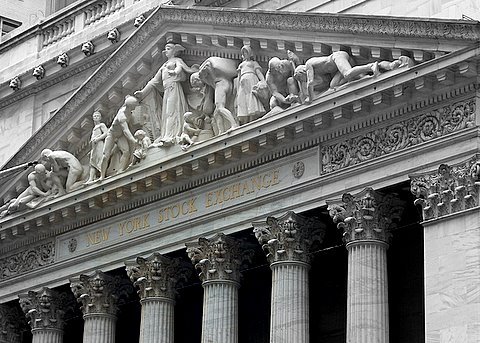 Facebook
Facebook
 X
X
 Instagram
Instagram
 TikTok
TikTok
 Youtube
Youtube

Not much is currently popular about Wall Street, but pre- recessions and depressions, America’s financial institutions reveled in a period of immense prosperity. From politics to architecture, Greek and Roman civilizations heavily influenced much of the culture. During this era of opulence, many monuments were erected across the nation.
In 1901, construction began on the New York Stock Exchange Building (NYSE). Four million dollars and three years later, hailed as masterful neoclassical architecture, it embodied the nation’s growth and success. It is, indeed, an admirable structure: atop the massive Corinthian columns that frame its façade, stands possibly the last bit of truth left on Wall Street.
Originally weighing 90 tons, these figural sculptures depict Integrity flanked by the sources of American prosperity: Agriculture, Mining, Science, Industry and Invention. Titled by its sculptor ”Integrity Protecting the Works of Man,” it is one of the most prominent features of this New York landmark.
Since the 9/11 terrorist attacks the NYSE building has been closed to the public, but just one block east, on 48 Wall Street, you’ll find the Exchange’s de facto visitor center – the Museum of American Finance.
Located in the historic former headquarters of the Bank of New York, it occupies 30,000 square feet and is the nation’s only public museum dedicated to finance, entrepreneurship and the free open market system. It is easily accessible via public transportation and no visit to Wall Street is complete without a stop here. For more information visit moaf.org.


Not much is currently popular about Wall Street, but pre- recessions and depressions, America’s financial institutions reveled in a period of immense prosperity. From politics to architecture, Greek and Roman civilizations heavily influenced much of the culture. During this era of opulence, many monuments were erected across the nation.
In 1901, construction began on the New York Stock Exchange Building (NYSE). Four million dollars and three years later, hailed as masterful neoclassical architecture, it embodied the nation’s growth and success. It is, indeed, an admirable structure: atop the massive Corinthian columns that frame its façade, stands possibly the last bit of truth left on Wall Street.
Originally weighing 90 tons, these figural sculptures depict Integrity flanked by the sources of American prosperity: Agriculture, Mining, Science, Industry and Invention. Titled by its sculptor ”Integrity Protecting the Works of Man,” it is one of the most prominent features of this New York landmark.
Since the 9/11 terrorist attacks the NYSE building has been closed to the public, but just one block east, on 48 Wall Street, you’ll find the Exchange’s de facto visitor center – the Museum of American Finance.
Located in the historic former headquarters of the Bank of New York, it occupies 30,000 square feet and is the nation’s only public museum dedicated to finance, entrepreneurship and the free open market system. It is easily accessible via public transportation and no visit to Wall Street is complete without a stop here. For more information visit moaf.org.